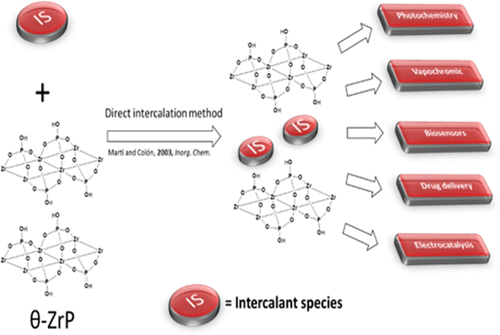当前位置:
X-MOL 学术
›
Acc. Mater. Res.
›
论文详情
Our official English website, www.x-mol.net, welcomes your feedback! (Note: you will need to create a separate account there.)
New Applications of Zirconium Phosphate Nanomaterials
Accounts of Materials Research ( IF 14.6 ) Pub Date : 2021-09-01 , DOI: 10.1021/accountsmr.1c00102 Mario V. Ramos-Garcés 1 , Julissa González-Villegas 2 , Aleannette López-Cubero 2 , Jorge L. Colón 2
Accounts of Materials Research ( IF 14.6 ) Pub Date : 2021-09-01 , DOI: 10.1021/accountsmr.1c00102 Mario V. Ramos-Garcés 1 , Julissa González-Villegas 2 , Aleannette López-Cubero 2 , Jorge L. Colón 2
Affiliation

|
The 2-D layers of the inorganic ion exchanger α-zirconium phosphate (Zr(HPO4)2·H2O, α-ZrP) make this compound particularly stable to low pH, high temperature, and ionizing radiation. Initially studied for its ion exchange properties, once the conditions for its synthesis in crystalline form was accomplished by James Stynes and Abraham Clearfield in 1964, numerous other types of studies and applications followed. Extensive studies in the 1960s and 1970s on the thermodynamics of ion exchange led to insights into the intercalation mechanism of this material. The Clearfield group solved the crystal structure in 1968 and refined it in 1977. Powder methods were pioneered by the Clearfield group to solve the structure of this type of materials. In 1968 Giulio Alberti reported means to prepare zirconium phosphonates expanding the chemistry of these layered compounds. New phases of ZrP were also discovered (e.g., γ, θ, λ, τ) and the applications ranged from heterogeneous catalysis to intercalation chemistry and solid-state proton conductors. Methods to exfoliate the layers of ZrP were developed in the 1990s as interest grew in new applications of these types of materials. For example, protein and enzyme intercalation was accomplished starting in the 1990s by the McLendon, Mallouk, and Kumar groups. In the early 2000s, the Colón group pioneered the use of the θ phase of ZrP for the direct intercalation of large inorganic metal complexes that could not be directly intercalated into the α phase. Initial studies in the Colón group ranged from applications of these directly intercalated ZrP derivatives in photophysics and photochemistry, amperometric biosensors, vapochromism, and vapoluminescence. Over the past decade, new applications of these materials have been developed in anticancer drug delivery and electrocatalysis of the oxygen evolution reaction (OER). ZrP has now proven to be a promising drug nanocarrier and its unique chemical microenvironment provided by the α-type layers and the interlayer space enhances catalytic activity for numerous types of reactions. Further elucidation of the catalytic active species under operando conditions as well as the chemical structure of drug-intercalated derivatives should provide new insights that will advance the design and development of new compounds with desired properties. The initial pioneering efforts of Clearfield and Alberti are being continued by numerous research groups providing new exciting areas of development on the chemistry of layered M(IV) phosphate and phosphonate compounds. In this Account we present the efforts of the Colón group during the past decade on studies of the applications of ZrP for anticancer drug delivery and electrocatalysis of the OER.
中文翻译:

磷酸锆纳米材料的新应用
无机离子交换剂α-磷酸锆(Zr(HPO 4 ) 2 ·H 2 )的二维层O, α-ZrP) 使该化合物对低 pH、高温和电离辐射特别稳定。最初对其离子交换特性进行了研究,一旦 James Stynes 和 Abraham Clearfield 在 1964 年完成了以结晶形式合成的条件,随后进行了许多其他类型的研究和应用。1960 年代和 1970 年代对离子交换热力学的广泛研究使人们深入了解了这种材料的嵌入机制。Clearfield 小组于 1968 年解决了晶体结构,并于 1977 年对其进行了改进。 Clearfield 小组率先采用粉末方法来解决此类材料的结构问题。1968 年 Giulio Alberti 报道了制备膦酸锆的方法,扩展了这些层状化合物的化学性质。还发现了 ZrP 的新相(例如,γ、θ、λ、τ) 和应用范围从多相催化到插层化学和固态质子导体。随着人们对这些类型材料的新应用越来越感兴趣,在 1990 年代开发了剥落 ZrP 层的方法。例如,蛋白质和酶的嵌入是在 1990 年代由 McLendon、Mallouk 和 Kumar 小组完成的。在 2000 年代初期,Colón 小组率先使用 ZrP 的 θ 相直接嵌入无法直接嵌入 α 相的大型无机金属配合物。Colón 小组的初步研究范围包括这些直接嵌入的 ZrP 衍生物在光物理学和光化学、电流生物传感器、蒸汽致变色和蒸汽发光中的应用。在过去的十年,这些材料在抗癌药物递送和析氧反应(OER)的电催化方面得到了发展。ZrP 现在已被证明是一种很有前途的药物纳米载体,其由 α 型层和层间空间提供的独特化学微环境增强了对多种反应的催化活性。进一步阐明操作条件下的催化活性物质以及药物嵌入衍生物的化学结构应该提供新的见解,这将促进具有所需特性的新化合物的设计和开发。许多研究小组正在继续 Clearfield 和 Alberti 最初的开创性努力,为层状 M(IV) 磷酸盐和膦酸盐化合物的化学提供新的令人兴奋的发展领域。
更新日期:2021-09-24
中文翻译:

磷酸锆纳米材料的新应用
无机离子交换剂α-磷酸锆(Zr(HPO 4 ) 2 ·H 2 )的二维层O, α-ZrP) 使该化合物对低 pH、高温和电离辐射特别稳定。最初对其离子交换特性进行了研究,一旦 James Stynes 和 Abraham Clearfield 在 1964 年完成了以结晶形式合成的条件,随后进行了许多其他类型的研究和应用。1960 年代和 1970 年代对离子交换热力学的广泛研究使人们深入了解了这种材料的嵌入机制。Clearfield 小组于 1968 年解决了晶体结构,并于 1977 年对其进行了改进。 Clearfield 小组率先采用粉末方法来解决此类材料的结构问题。1968 年 Giulio Alberti 报道了制备膦酸锆的方法,扩展了这些层状化合物的化学性质。还发现了 ZrP 的新相(例如,γ、θ、λ、τ) 和应用范围从多相催化到插层化学和固态质子导体。随着人们对这些类型材料的新应用越来越感兴趣,在 1990 年代开发了剥落 ZrP 层的方法。例如,蛋白质和酶的嵌入是在 1990 年代由 McLendon、Mallouk 和 Kumar 小组完成的。在 2000 年代初期,Colón 小组率先使用 ZrP 的 θ 相直接嵌入无法直接嵌入 α 相的大型无机金属配合物。Colón 小组的初步研究范围包括这些直接嵌入的 ZrP 衍生物在光物理学和光化学、电流生物传感器、蒸汽致变色和蒸汽发光中的应用。在过去的十年,这些材料在抗癌药物递送和析氧反应(OER)的电催化方面得到了发展。ZrP 现在已被证明是一种很有前途的药物纳米载体,其由 α 型层和层间空间提供的独特化学微环境增强了对多种反应的催化活性。进一步阐明操作条件下的催化活性物质以及药物嵌入衍生物的化学结构应该提供新的见解,这将促进具有所需特性的新化合物的设计和开发。许多研究小组正在继续 Clearfield 和 Alberti 最初的开创性努力,为层状 M(IV) 磷酸盐和膦酸盐化合物的化学提供新的令人兴奋的发展领域。



























 京公网安备 11010802027423号
京公网安备 11010802027423号